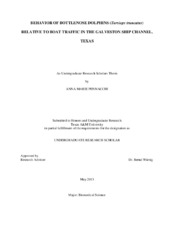| dc.description.abstract | Heavy boat traffic can negatively affect dolphins by increasing the risk of habitat disruption, emigration, or physical harm by boat propellers. It is important to assess the behaviors of the resident population of bottlenose dolphins (Tursiops truncatus) in the Galveston Ship Channel, near the entrance to the second busiest port in the USA, as a 5.2 billion dollar expansion of the Panama Canal is to be completed in 2015 that will bring more and larger ships to Galveston Bay. Hour-long surveys were conducted from a shore-based station along the Galveston Ship Channel in the morning, mid-afternoon, and late-afternoon from August through December 2012. Group size, number of boats, type of boat, and predominant behavior of dolphin groups were recorded during each survey. I predicted a decrease in social behavior and an increase in travelling behavior as boat traffic increased, as noted in previous studies of short-term behavioral shifts of dolphins during periods of heavy boat traffic. Chi squared contingency tests showed that the behaviors of dolphins varied significantly relative to the number of boats, but not the type of boat. However, contrary to predictions, socializing behavior did not change inversely proportionately to boat traffic nor did travelling behavior increase with increasing traffic. Behaviors varied relative to group size, and smaller groups were found in the presence of industrial than non-industrial boats. Behaviors did not change with time of day, although the number of industrial boats increased with time of day. The results suggest that several factors influence behavioral decisions of socially complex dolphins. As smaller group sizes were found in the presence of industrial boats, expansion of the ship channel could potentially disrupt dolphin interactions and habitat use. Further studies are necessary to better understand potential effects of increased ship traffic on the local dolphin population and to establish effective mitigation protocols. | en |


